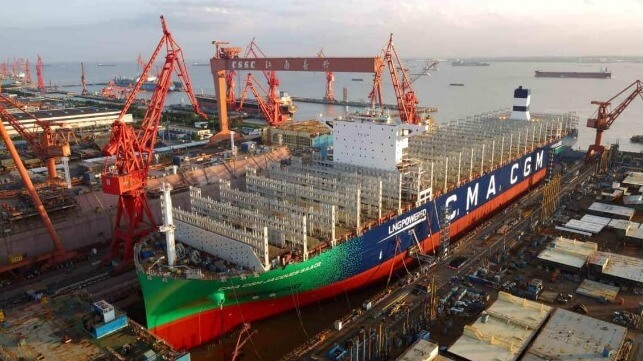U.S. Moves to Finalize Chinese-Built Ship Fees

The U.S. Trade Representative’s office is conducting its public hearings today, May 19, as it also closes the comment period for the proposed fees on Chinese-built ships and other elements, including port cranes. As it moves to finalize the structure, the shipping industry continues to oppose the proposed fees, while individual companies report they have strategies to avoid the fees.
The plan for how to penalize China for its unfair trade practices in shipbuilding was released in mid-April after USTR, acting on a complaint from five U.S. unions, found that the Chinese government was unfairly subsidizing its shipbuilders. It said China had aggressively moved to dominate global shipbuilding to the detriment of the U.S. and others.
The April proposal was a revision that restructured some of the elements the shipping industry had found onerous, lowering the costs, but continues to improve fees on Chinese shipping companies and Chinese-built ships calling at U.S. ports. It added a universal fee on all foreign-built car and vehicle carriers and imposes fees and regulations to shift a portion of U.S. LNG exports onto U.S.-built ships.
Well-known industry analyst Lars Jensen, CEO of Vespucci Maritime, commenting on the likely outcome of the current hearings and comment period, concludes, “We might expect fewer revisions this time around.” He, however, warns that shippers should expect carriers will attempt to pass on costs in the form of new surcharges.
The lobbying group, the World Shipping Council, has continued its strong opposition submitting comments in this round over its continued serious concerns. It asserts that a “tax on all foreign vessels far exceeds the authority of the USTR.” They have called the proposed fee regime “a step in the wrong direction” to rebuild the U.S. merchant marine, noting the fees are retroactive and potentially disrupting long-term investment planning among carriers.
The WSC’s opposition centers on the fees based on net tonnage, which it says disproportionately penalize larger, more efficient vessels and U.S. ports that made significant investments to expand their capacity. It calls the universal fee on all foreign-built car carriers an “arbitrary action,” asserting that it will do little to encourage U.S. maritime investment. It asserts the calculations are incorrect in the proposal and calls for a per vehicle fee that applies credit for exported vehicles on the same vessel.
Jansen, however, called the second-round proposal “more manageable from a container shipping perspective.” He, too, however, notes it still contains “problematic elements,” such as the fees on car carriers.
Shipping lines, however, have already begun to plan for steps to avoid the U.S. fees on Chinese-built ships. CMA CGM’s finance director on Friday told reporters that all shipping firms, including China’s COSCO, “would adapt.”
CMA CGM notes that less than half its fleet of approximately 670 ships is Chinese-built. It said it would reorganize its operations to ensure that it does not pay the U.S. port fees.
If the second round only undergoes smaller modifications, Jansen notes it would come into effect in mid-October or 180 days after adoption.
